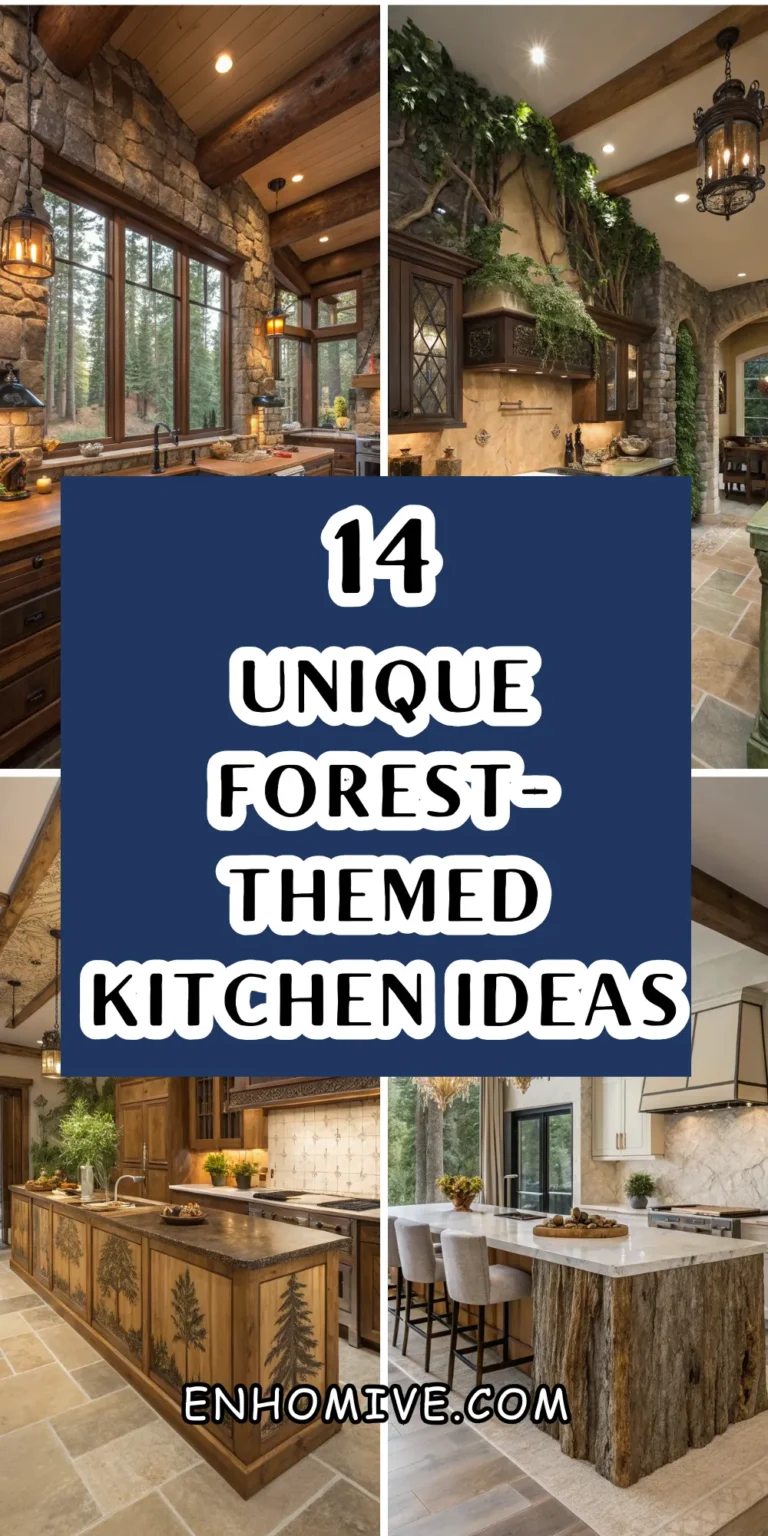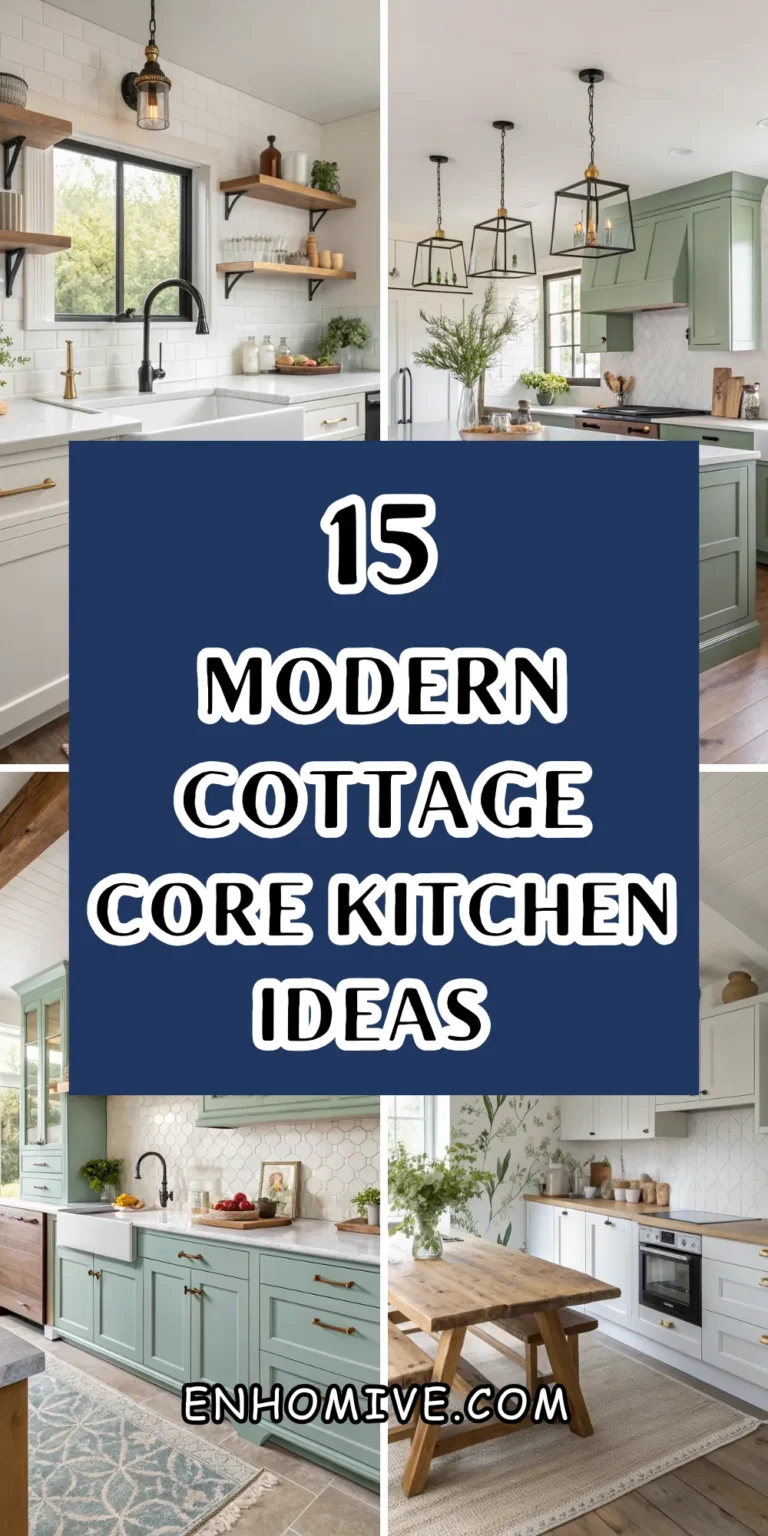14 Boho Dining Room Ideas for a Cozy Space
Creating a bohemian dining room means embracing warmth, creativity, and the beautiful imperfection that makes a space feel lived-in and loved. The boho style celebrates global influences, natural materials, and personal collections that tell your unique story through layers of texture, color, and meaningful objects collected over time.
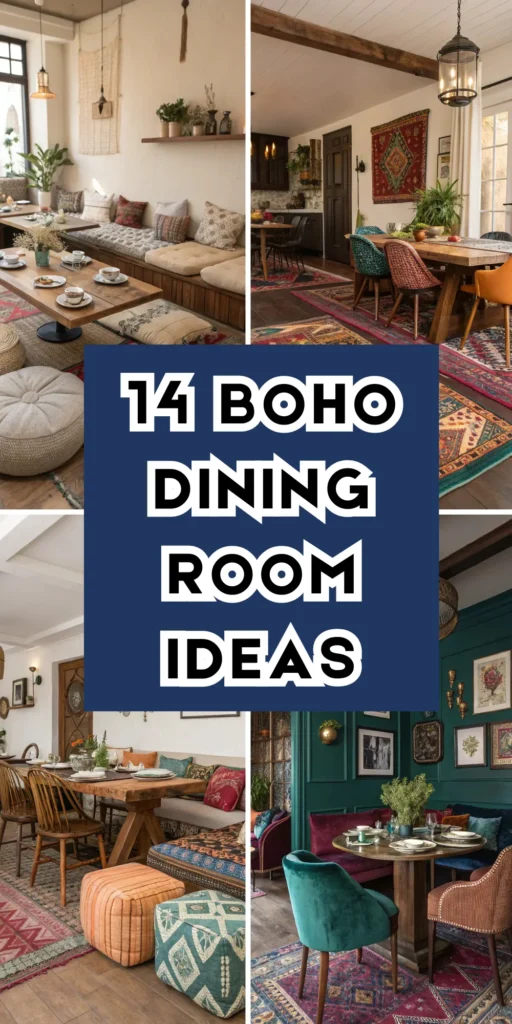
Most dining rooms feel formal and untouchable, designed more for special occasions than daily family life. A boho dining space invites lingering conversations, spontaneous gatherings, and the kind of relaxed hospitality that makes everyone feel welcome. From mixed patterns to natural textures, these ideas will help you create a dining room that feels like a warm embrace every time you sit down for a meal.
Layered Vintage and Global Textiles
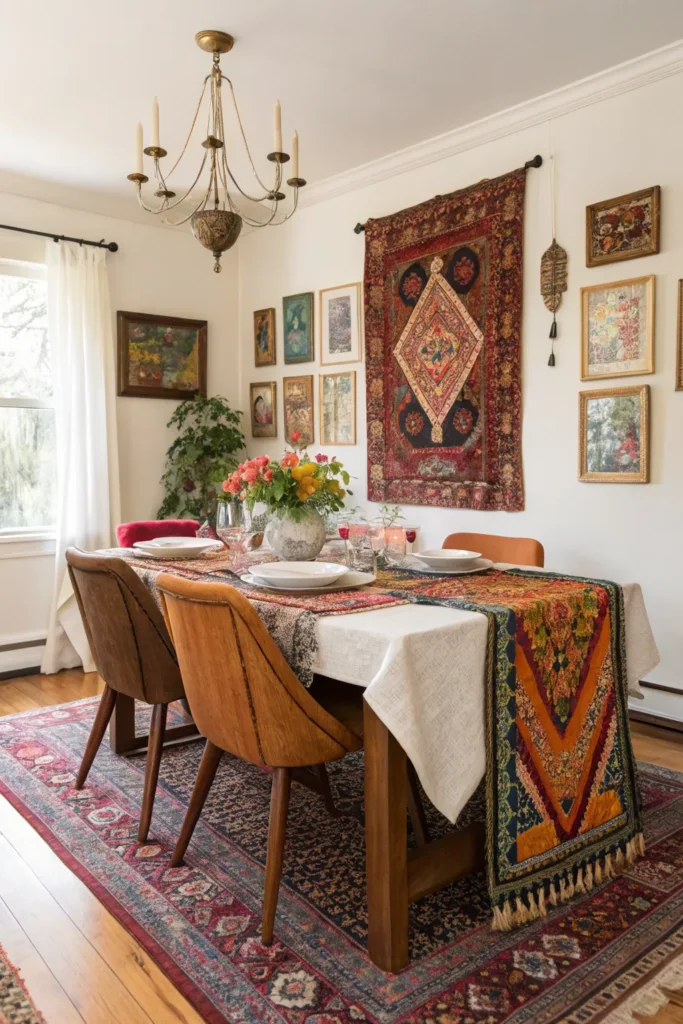
Why try this? Mixed textiles create visual richness and warmth while showcasing global craftsmanship and cultural appreciation.
Implementation: Layer vintage Persian rugs under your dining table, drape colorful throws over chairs, and hang textile art on walls. Mix patterns like ikat, suzani, kilim, and block prints in coordinating color families. Include table runners, placemats, and napkins in complementary patterns.
Who benefits: Those who love color and pattern, and anyone wanting to create globally-inspired spaces that feel traveled and worldly.
Pro tip: Start with one large patterned element like a rug, then add smaller patterns in similar color tones to avoid overwhelming the space.
Macrame and Woven Wall Hangings
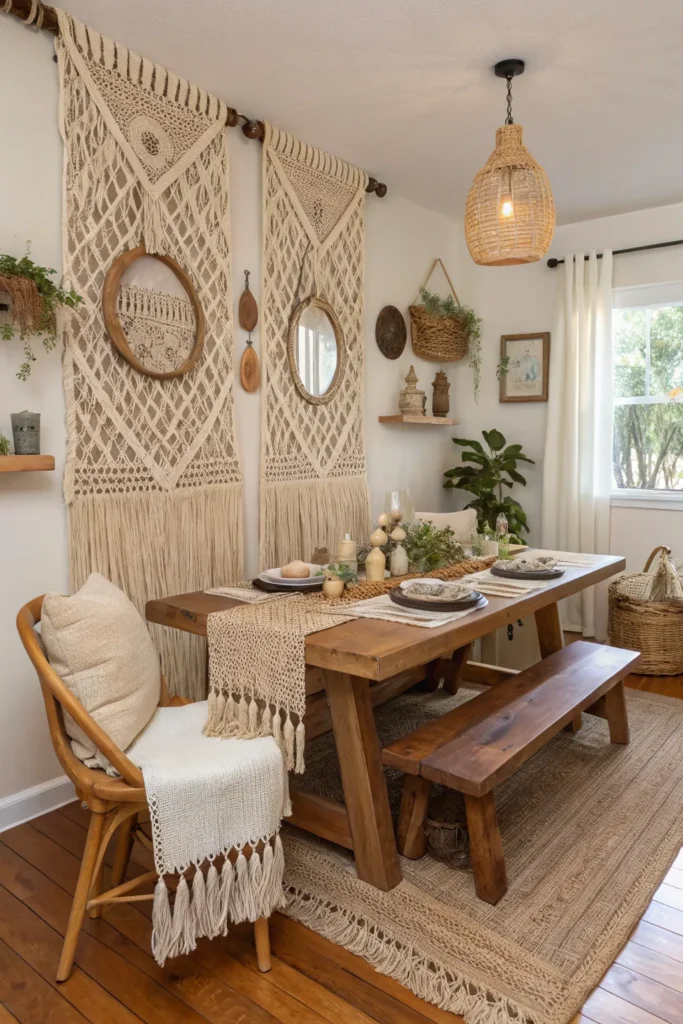
Create textural interest with handcrafted wall art that adds bohemian softness and artisanal charm.
Implementation: Hang large macrame pieces behind your dining table or create gallery walls mixing woven textiles, macrame, and small mirrors. Choose pieces in natural fibers like cotton, jute, or wool in cream, tan, and earth tones.
Best for: Those appreciating handmade crafts and anyone wanting to add warmth to rooms with hard surfaces like wood floors and dining tables.
Con: Textile wall hangings collect dust and cooking odors—choose washable pieces for dining areas or plan for regular cleaning.
Mixed Seating with Global Influences

Why try this? Combining different chair styles creates casual, collected-over-time feeling that’s quintessentially bohemian.
Steps: Mix wooden dining chairs with upholstered ones, add a bench on one side, or include floor cushions for flexible seating. Incorporate globally-inspired pieces like Moroccan poufs, Indian carved chairs, or Mexican equipales.
Why it works: Creates relaxed, inclusive atmosphere where formal dining rules don’t apply and everyone finds their perfect spot.
Pro tip: Unify mismatched seating with consistent cushions, throws, or paint colors while maintaining each piece’s unique character.
Abundant Plant Life and Hanging Gardens
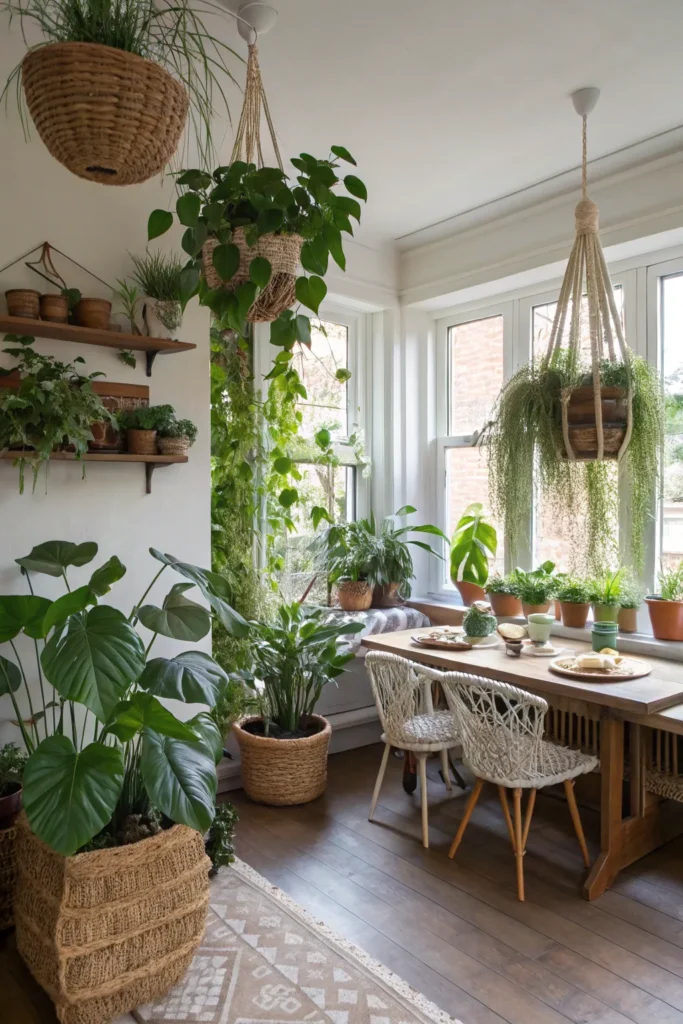
Transform your dining room into an indoor oasis with lush plants that purify air and add natural vitality.
How to: Create hanging plant displays with macrame hangers, add large floor plants in woven baskets, and place small plants along windowsills. Choose low-maintenance varieties like pothos, snake plants, and philodendrons that thrive in various light conditions.
Why it matters: Plants improve air quality while adding natural color and texture that makes dining spaces feel fresh and alive.
Styling tip: Vary plant heights and pot materials—mix ceramic, woven baskets, and terracotta for authentic boho layering.
Warm, Ambient Lighting Design
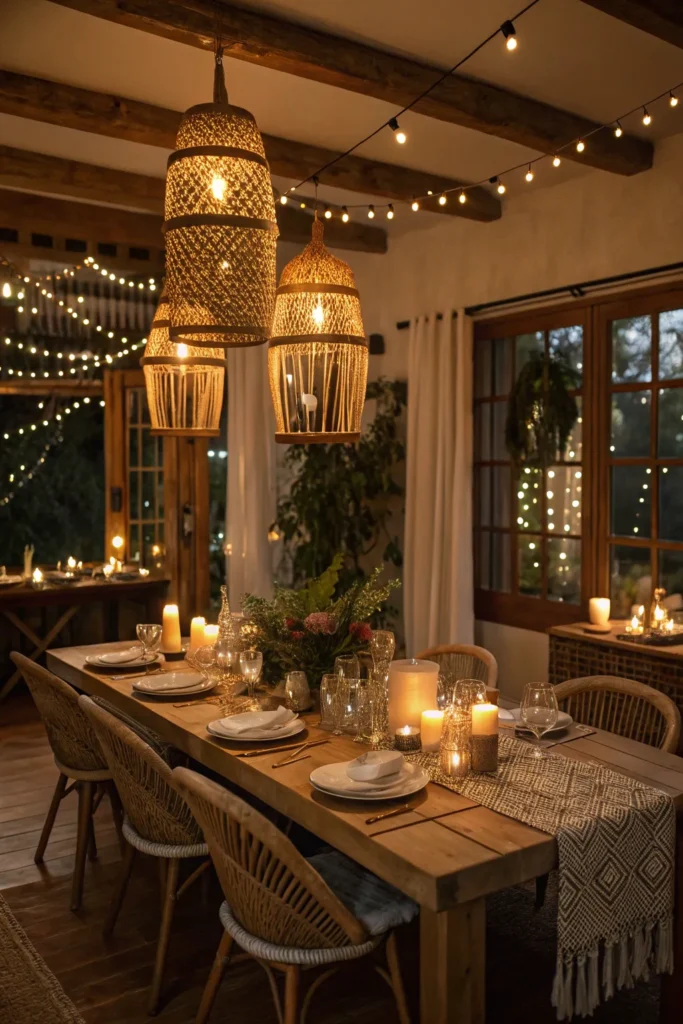
Install layered lighting that creates intimate, golden-hour atmosphere perfect for long, leisurely meals.
Implementation: Combine pendant lights over the table with string lights around windows, candles on surfaces, and table lamps in corners. Choose warm bulbs (2700K-3000K) and fixtures made from natural materials like rattan, wood, or woven fibers.
Who benefits: Those wanting romantic, cozy dining atmosphere and anyone hosting frequent dinner parties or family gatherings.
Downside: Dim lighting can make food prep and cleanup challenging—ensure adequate task lighting when needed.
Natural Wood and Rattan Furniture
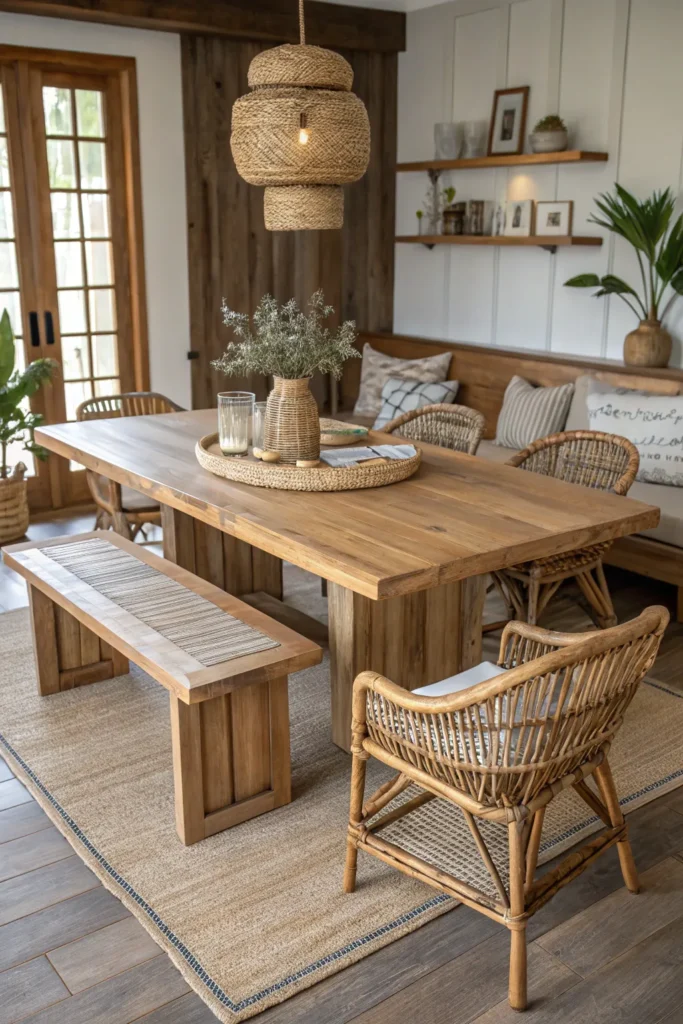
Create organic warmth with furniture pieces that celebrate natural materials and handcrafted construction.
Steps: Choose dining tables with visible wood grain, add rattan or wicker chairs, and incorporate natural wood serving pieces. Mix light and dark woods for interesting contrast while maintaining earthy, natural palette.
Best for: Those drawn to sustainable, natural materials and anyone wanting furniture that ages beautifully over time.
Pro tip: Mix smooth and textured woods—pair sleek walnut tables with rough-hewn benches for interesting material contrast.
Colorful Patterned Rugs and Floor Coverings
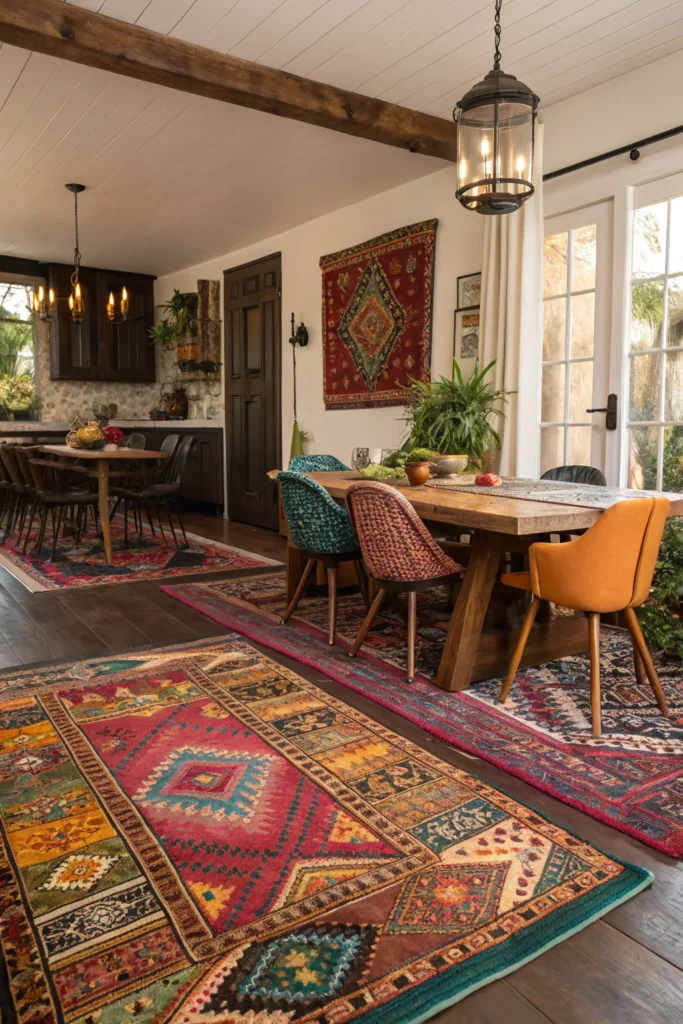
Why try this? Bold rugs anchor seating areas while adding pattern, color, and cultural influences to dining spaces.
How-to: Layer multiple rugs for maximum boho impact, or choose one large vintage or vintage-inspired rug with rich colors and traditional patterns. Consider Persian, Moroccan, or Turkish designs in jewel tones or faded vintage colorways.
Why it’s helpful: Defines dining area in open floor plans while adding warmth underfoot and visual richness that makes spaces feel cozy.
Con: Light-colored or delicate rugs may not withstand dining room spills—choose washable or darker patterns for high-traffic areas.
Gallery Walls with Personal Collections
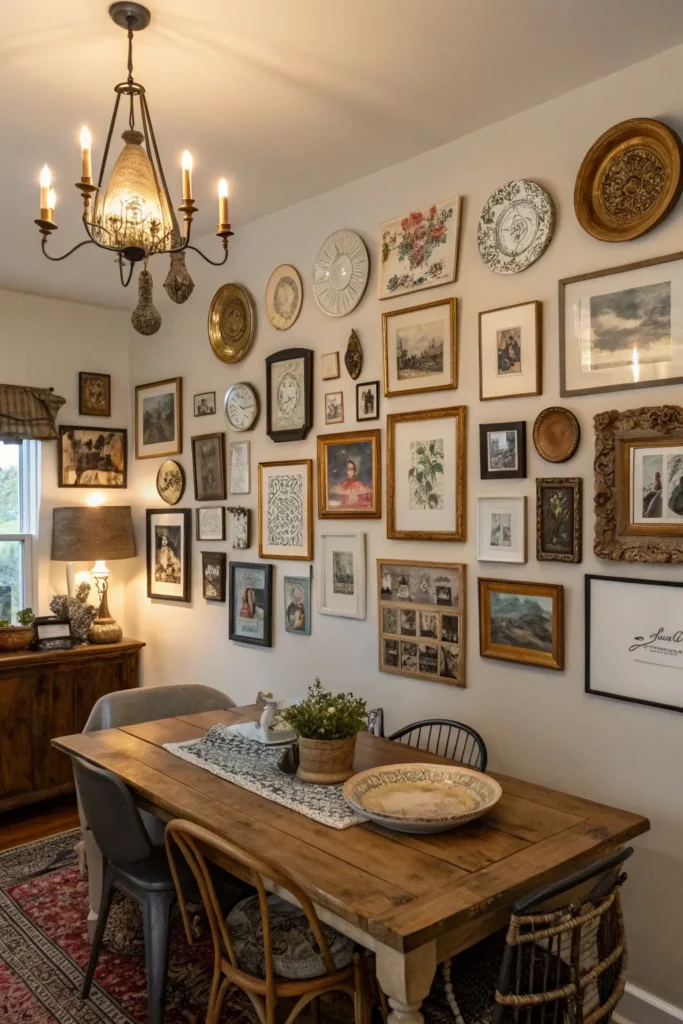
Wall-mount eclectic collections of artwork, photographs, and meaningful objects that tell your personal story.
How to: Mix framed artwork with small shelves holding treasures, vintage plates, mirrors, and personal photographs. Vary frame sizes and finishes while maintaining cohesive color palette. Include pieces collected from travels or family heirlooms.
Why it’s great: Creates conversation starters while displaying personality and memories that make guests feel welcomed into your personal space.
Drawback: Can feel cluttered if not carefully curated—edit ruthlessly and group similar items for visual cohesion.
Jewel Tone Accent Colors
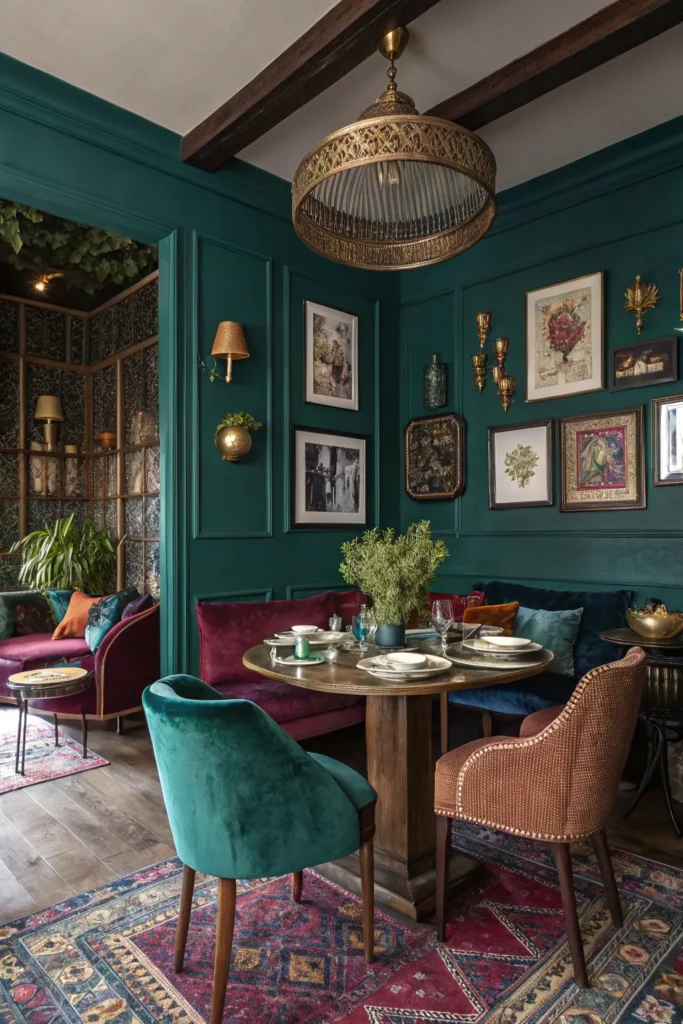
Create rich, luxurious atmosphere with deep, saturated colors that evoke global markets and exotic destinations.
Benefits: Deep colors like emerald green, sapphire blue, and rich burgundy create intimate, sophisticated atmosphere perfect for dinner parties. Jewel tones pair beautifully with natural materials and metallic accents.
Steps: Add jewel tones through chair cushions, artwork, ceramics, and textiles while keeping larger elements neutral for balance. Use metallic accents in brass or copper to enhance rich colors.
Best for: Those wanting dramatic, sophisticated bohemian style rather than purely natural or neutral approaches.
Pro tip: Use jewel tones as accents against neutral backgrounds to prevent overwhelming or darkening smaller dining spaces.
Vintage and Antique Furniture Pieces
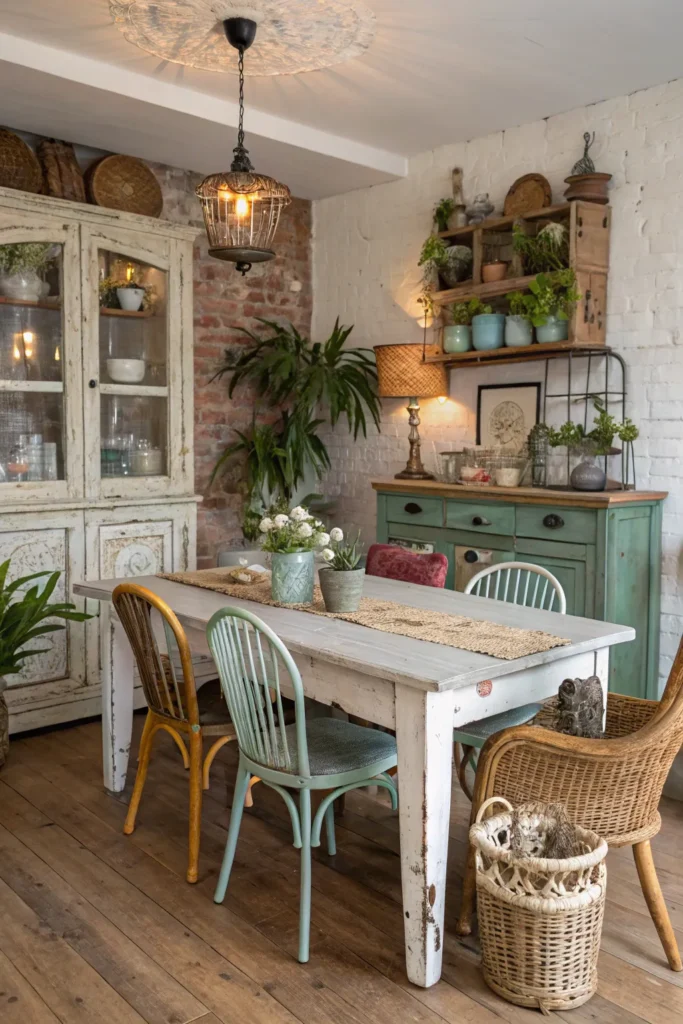
Add character and history with furniture pieces that have stories to tell and patina that can’t be manufactured.
How to: Mix vintage dining chairs, antique sideboards, or inherited family pieces with newer elements. Embrace imperfections like worn finishes or minor repairs that add authentic character.
Who it’s for: Treasure hunters who love unique finds and anyone wanting furniture with history and soul rather than mass-produced pieces.
Con: Vintage pieces may need repairs or refurbishing—factor in additional time and cost for restoration when needed.
Moroccan or Middle Eastern Influences
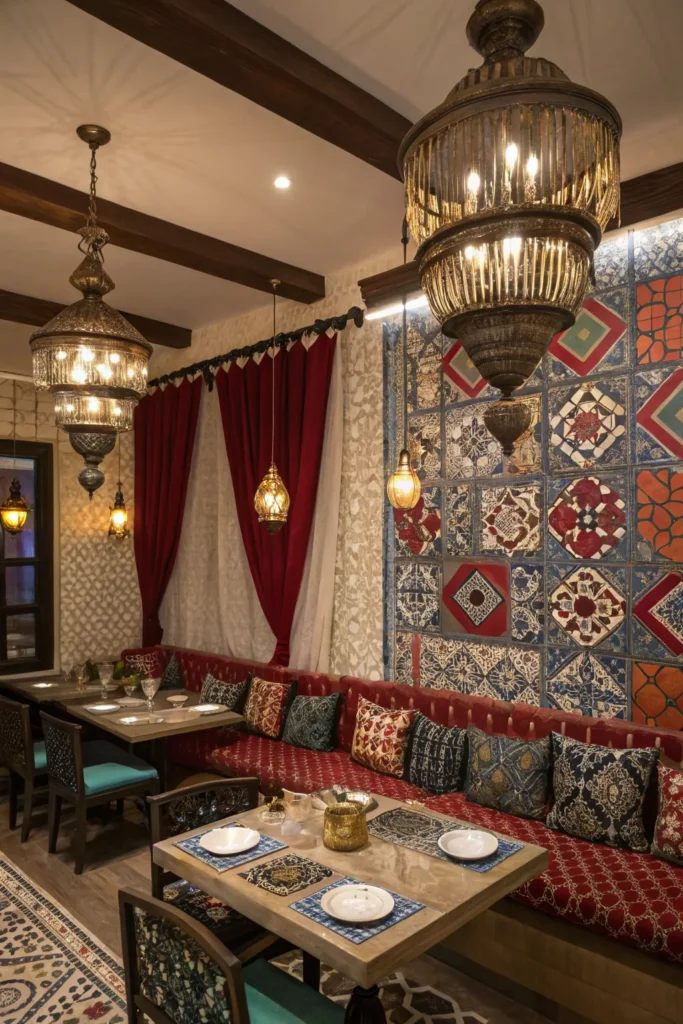
Install exotic elegance with design elements inspired by North African and Middle Eastern decorative traditions.
Implementation: Add Moroccan lanterns, patterned tiles as trivets, brass serving pieces, and geometric patterns in textiles. Choose warm color palettes with rich reds, deep blues, and metallic accents.
Why it matters: Creates exotic, worldly atmosphere that transports diners to faraway places while celebrating beautiful craftsmanship traditions.
Downside: Can feel theme-heavy if overdone—use these elements as accents within broader boho palette rather than complete room theme.
Natural Fiber and Woven Accessories
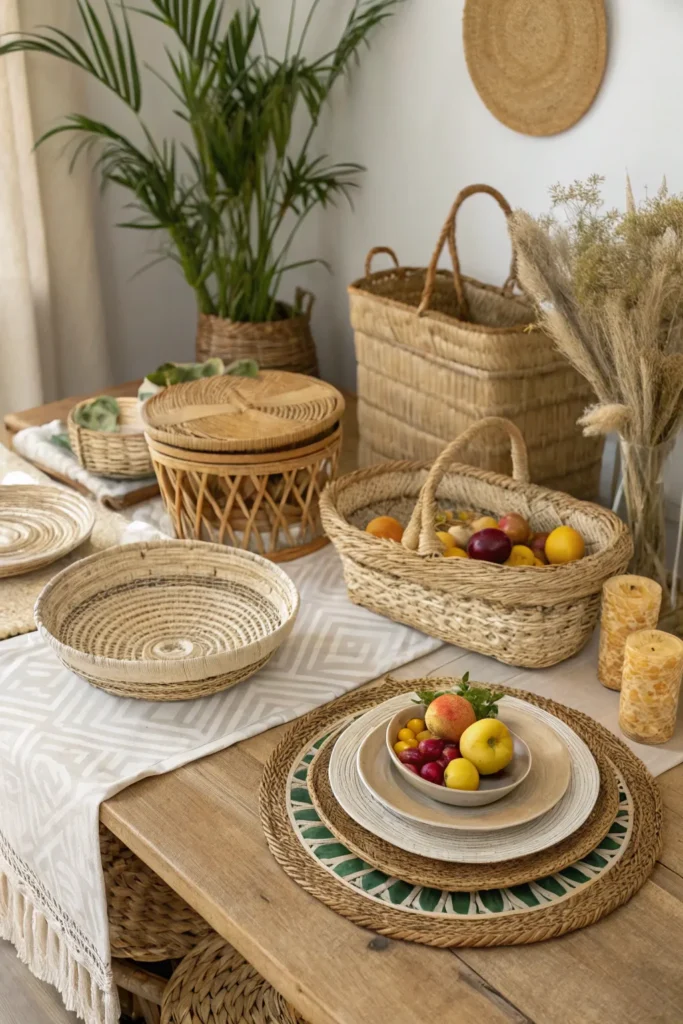
Create organic texture with baskets, placemats, and decorative objects made from natural materials like seagrass, jute, and bamboo.
Steps: Use woven chargers under plates, display fruits in wicker baskets, and store dining linens in large baskets. Mix different weaving patterns and natural colors for visual interest while maintaining earthy palette.
Best for: Those wanting sustainable, eco-friendly decorating options and anyone drawn to handcrafted, artisanal accessories.
Styling tip: Group baskets in odd numbers and vary sizes for pleasing visual arrangements that feel intentional rather than scattered.
Low Seating and Floor Cushion Areas
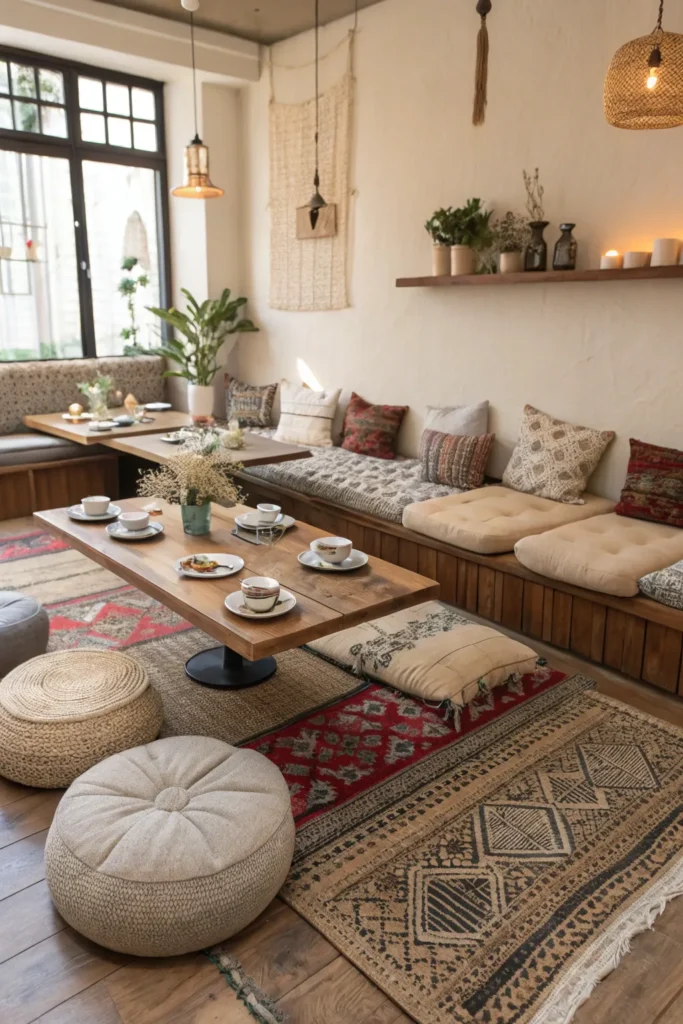
Create casual, relaxed dining experiences with low tables and comfortable floor seating that encourages lingering.
How-to: Use low coffee tables or ottomans as dining surfaces with large floor cushions, poufs, or meditation cushions for seating. Create cozy corners with layered rugs and soft textiles for informal meals or tea service.
Why it works: Encourages relaxed, intimate dining experiences and works especially well for households with children who enjoy casual, flexible seating options.
Pro tip: Provide back support with wall cushions or low benches for comfortable extended sitting during longer meals.
Metallic Accents in Brass and Copper
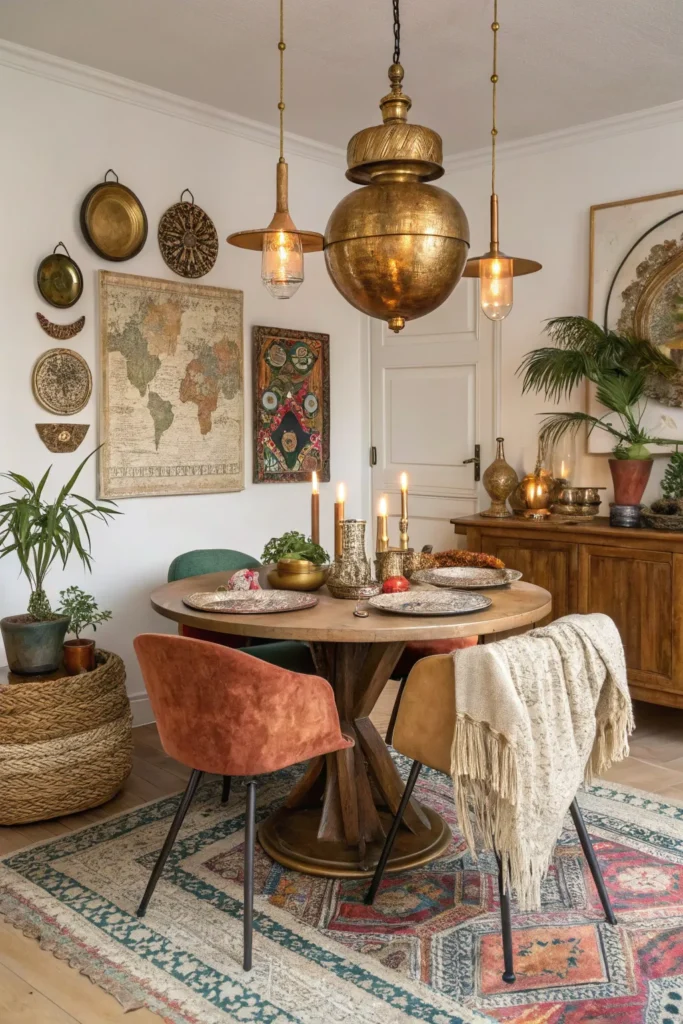
Make dining spaces feel warm and luxurious with metallic elements that reflect candlelight and add glamorous touches.
Implementation: Choose brass or copper light fixtures, serving pieces, candlesticks, and decorative objects. Mix different metallic finishes for collected, layered appearance rather than perfectly matched sets.
Best for: Those wanting to add glamour to bohemian style and anyone appreciating warm metallics over cool chrome or silver finishes.
Con: Brass and copper require regular polishing to maintain shine, or embrace natural patina for authentic aged appearance.
The heart of bohemian dining room style lies in creating spaces that feel personal, welcoming, and slightly rebellious against formal dining traditions. Great boho dining rooms should make everyone feel comfortable putting their elbows on the table while celebrating the beauty of imperfection and global inspiration.
Remember that authentic bohemian style develops over time through collected pieces, travel finds, and inherited treasures rather than coordinated furniture sets. Start with natural materials and warm colors, then layer in textiles, plants, and personal collections that reflect your individual journey. Your boho dining room should feel like a warm embrace that invites long conversations, spontaneous gatherings, and the kind of relaxed hospitality that turns meals into memorable experiences.





